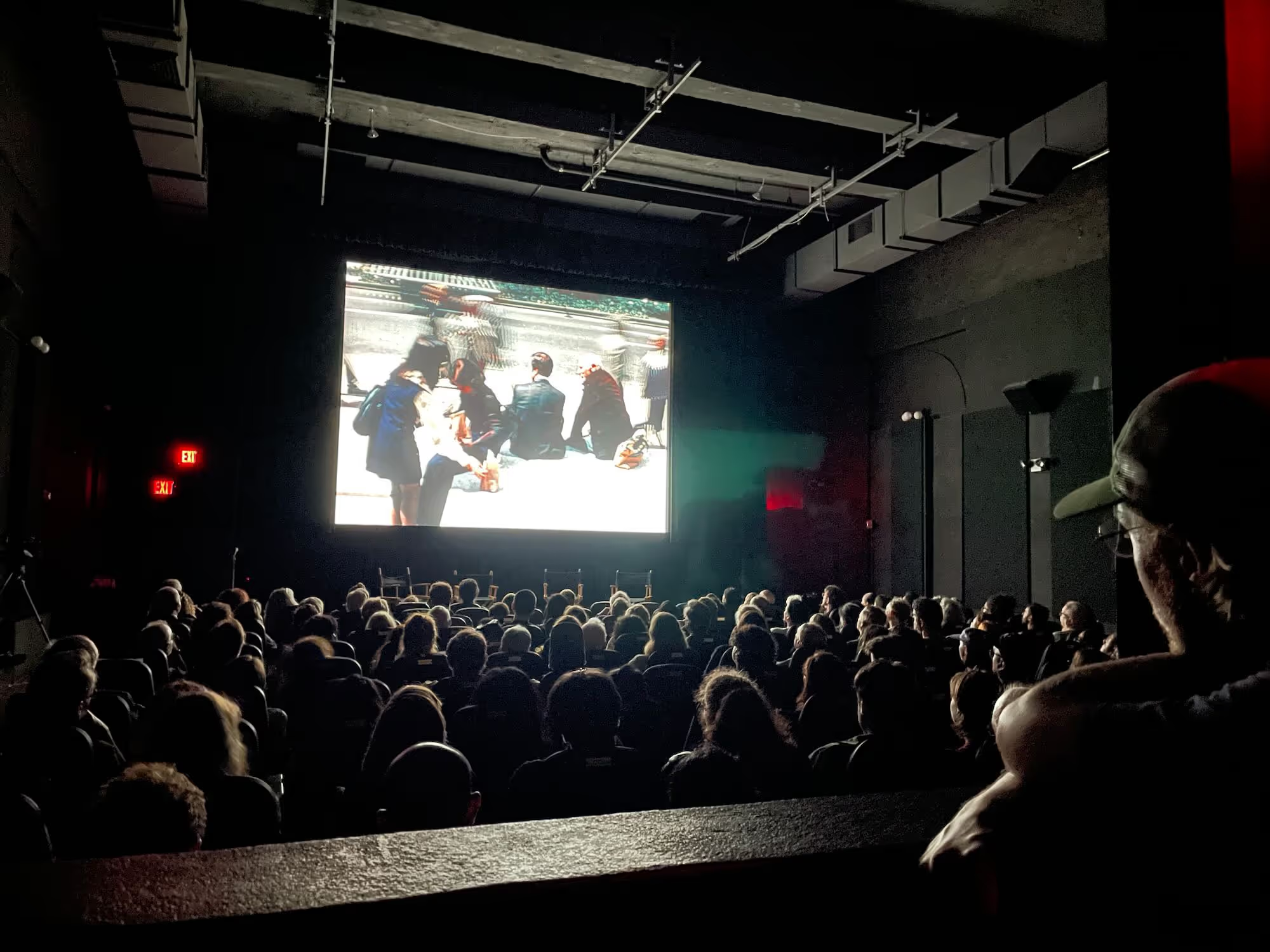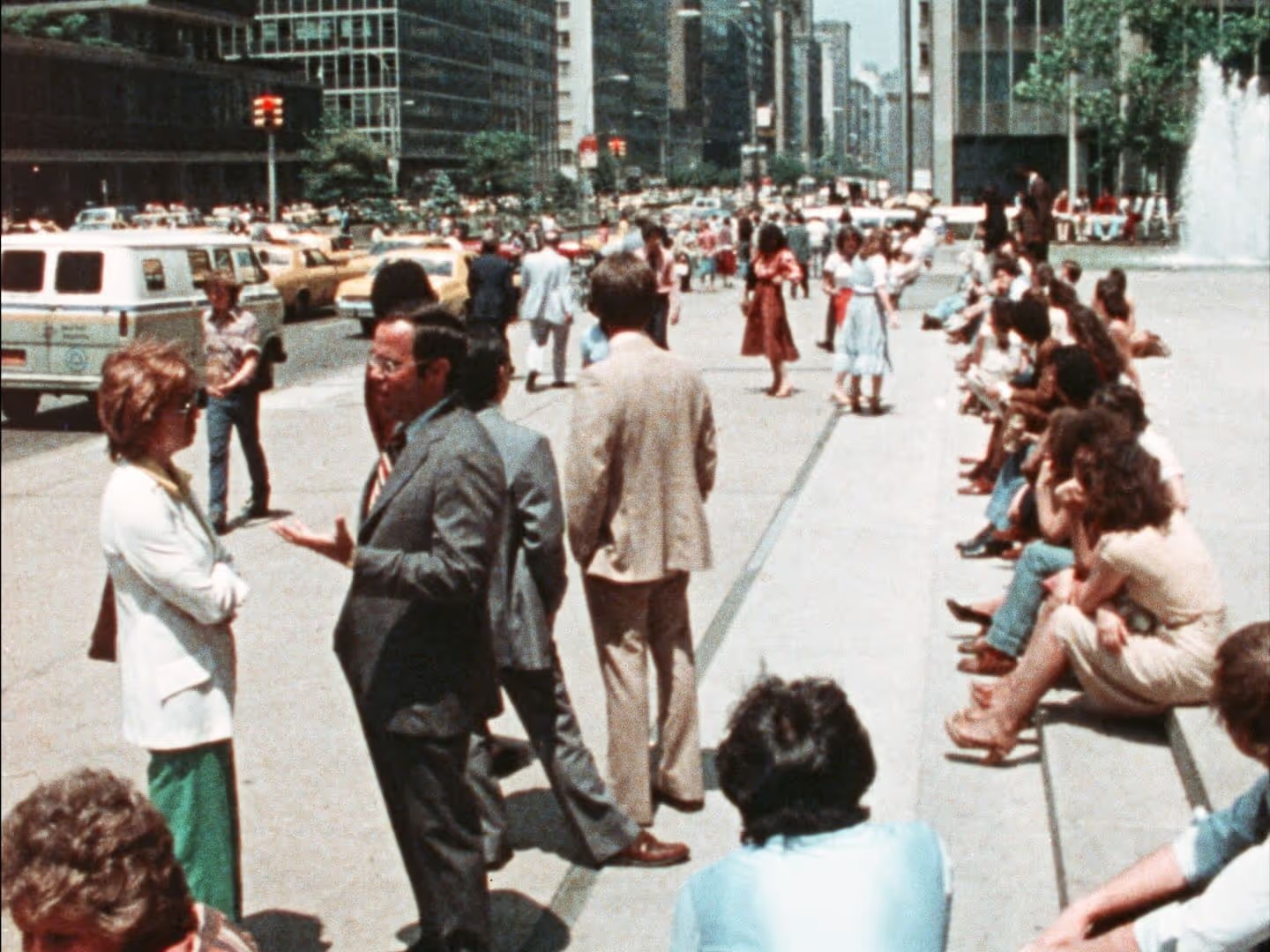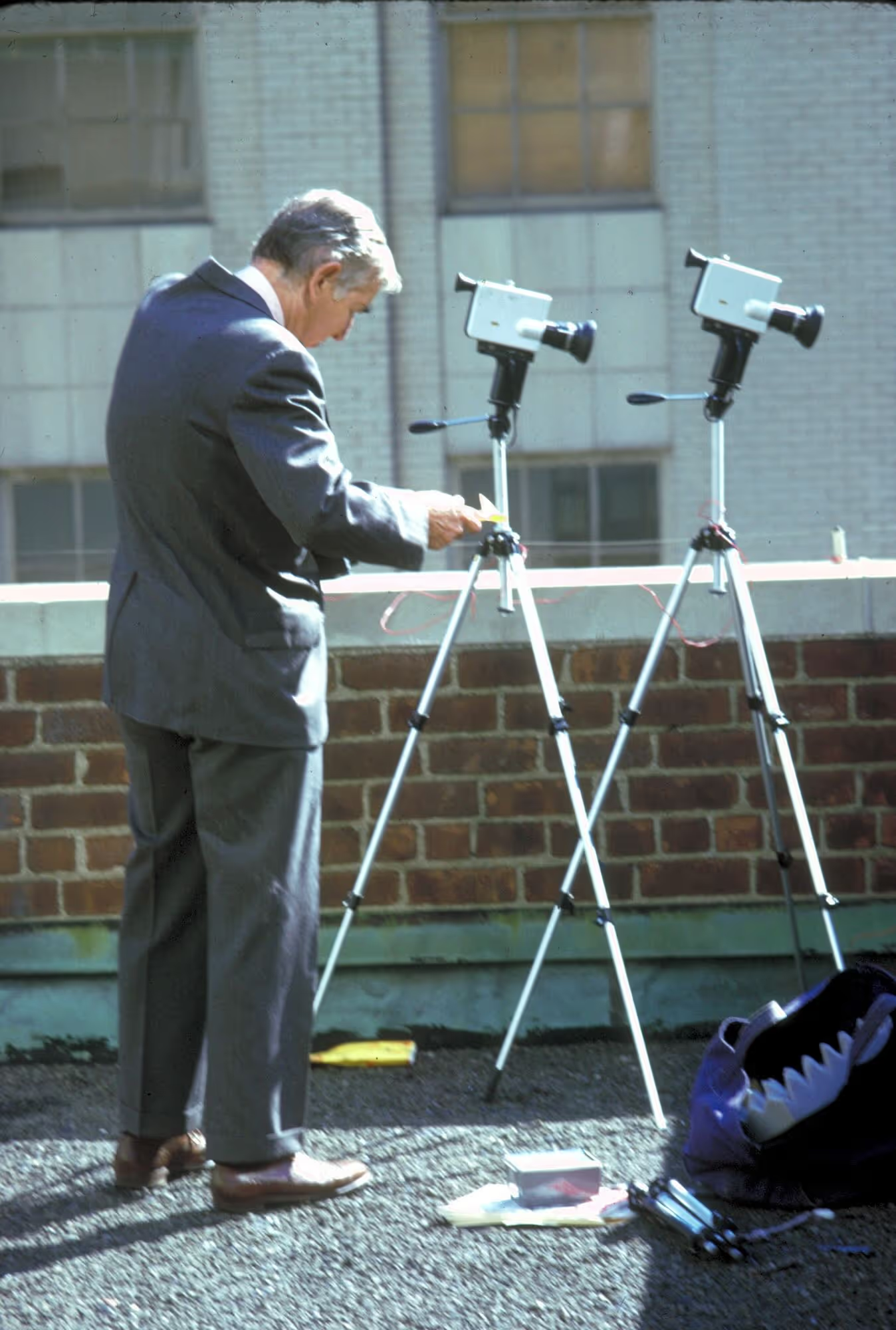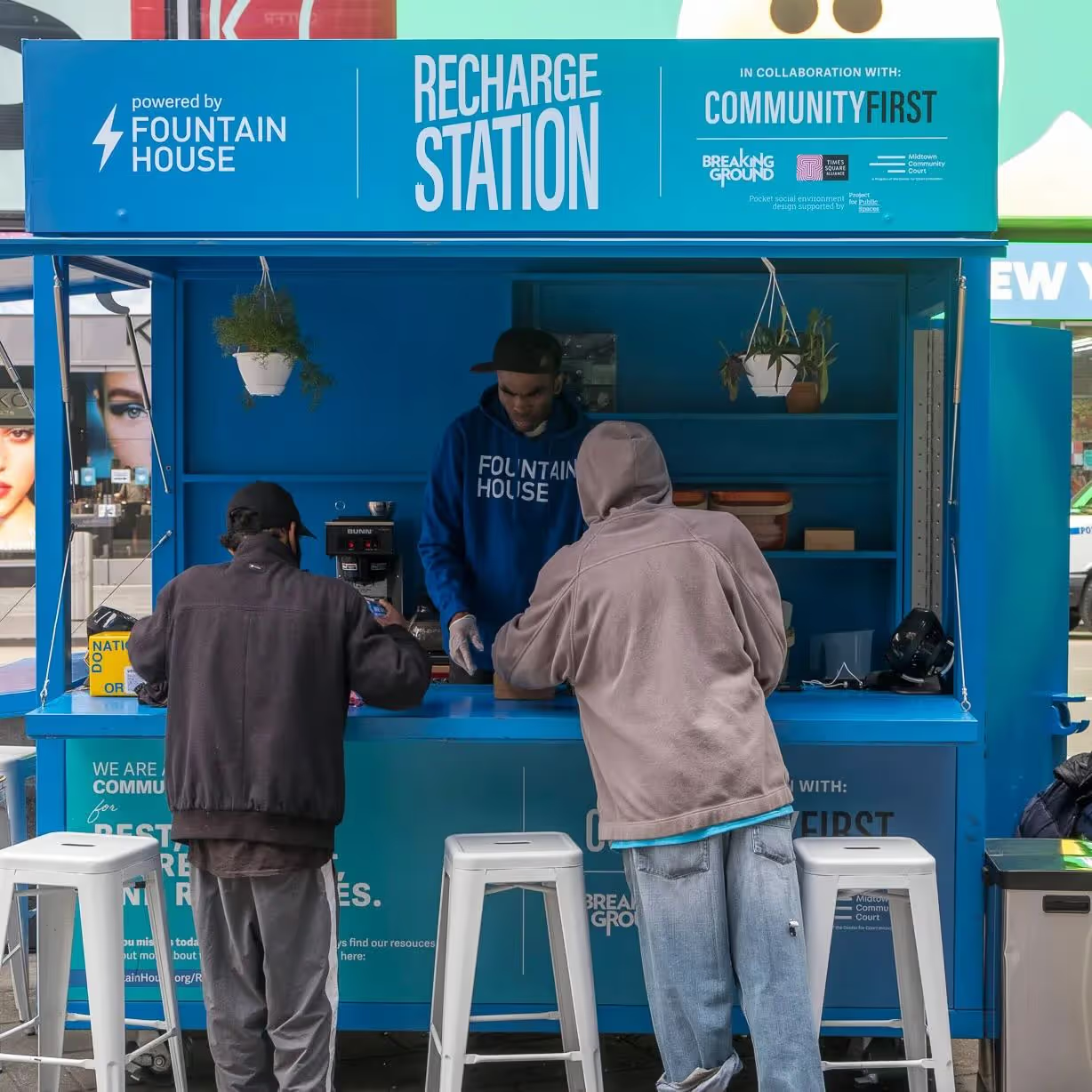A biweekly newsletter with public space news, resources, and opportunities.
A curated dispatch on all things public markets plus the latest announcements from the Market Cities Program.
On Friday, September 26, 2025, a sold-out crowd filled the theater at the Anthology Film Archives (AFA) in Manhattan’s East Village, eager to watch a newly restored version of a beloved classic.
William H. “Holly” Whyte’s The Social Life of Small Urban Spaces—a documentary that has played as a staple in countless urban planning, landscape architecture, and architecture classrooms for over 45 years—was finally showing on the big screen. Once accessible only through educational DVDs and unofficial YouTube uploads, the film has now been beautifully restored to digital format by AFA, in partnership with Project for Public Spaces and The Municipal Art Society of New York (MAS). The restoration premiered as part of a week-long “revival run,” bringing this seminal work back to the big screen in all its original charm.

The revival couldn’t have come at a better time. William H. Whyte’s Street Life Project and groundbreaking work laid the foundation for Fred Kent’s founding of Project for Public Spaces, which proudly celebrates its 50th anniversary this year! This milestone presented a full-circle moment to revisit Whyte’s influential work alongside our partners at MAS—who originally produced the 16mm film in 1980—and more than 170 audience members who eagerly joined us for a cinematic journey back to the streets of 1970s New York City.
Following the screening, Project for Public Spaces' Co-Executive Director Nate Storring led an engaging panel discussion with David Burney, co-founder of Pratt Institute’s Urban Placemaking and Management program; Rosa Chang, Co-Founder & President of Gotham Park; and Claire Weisz, Founding Partner of WXY Architecture. Together, they reflected on Whyte’s enduring legacy and the transformative ways his approach continues to shape how we observe, design, and steward public spaces today.
In this article, we revisit some of our key takeaways on public space today from the screening and panel discussion.
William H. Whyte’s film and companion book revealed a simple but powerful truth: the best way to design successful public spaces is to carefully observe how people actually use them. Whyte and his team uncovered that it wasn’t the amount of open space that attracted users—in fact, the opposite was often true. The strongest correlation to usability was with the amount of sittable space available.
“People tend to sit where there are places to sit.”
—William H. “Holly” Whyte

In our placemaking work today, Project for Public Spaces works closely with communities to reimagine their public spaces. We equip them with observational tools that help evaluate the effectiveness of their current spaces. By channeling their inner Holly Whyte, these insightful exercises create a foundation for stakeholders to start to imagine what the space can become. Not surprisingly, no matter the space, the lack of seating is often one of the first setbacks that gets noticed.

Despite decades of progress, some of the most obvious issues in public space remain unresolved. At our panel discussion, David Burney remarked that while we have come a long way, basic challenges—like providing adequate seating—still persist.
“We stumble on these self-evident truths. How come we haven’t figured it out?” he asked.
Burney pointed out, today’s professionals have the advantage of learning from decades of research and the use of powerful technology and tools like geographic information systems (GIS), which can clearly show, in real time, the undeniable links between poor health outcomes and limited access to open space. Yet while today’s understanding of public space impact helps build a compelling case, more than ever before, for investing in high-quality public spaces, the industry still grapples with the challenges of aging infrastructure, bureaucracy, lack of political will, and more, as found in our 2025 State of Public Space Survey of over 700 professionals. Seating was once a hot topic in the field of public space, but over the years, we’ve come to realize that it's not only about design. Many factors, including our civic leaders, community members, culture, and reliance on technology, influence the long-term environmental and social health of our cities.
At the premier showing, the audiences roared with laughter as Whyte poked fun at hostile architecture that attempted—sometimes unsuccessfully—to deter people from sitting, loitering, or gathering. Tactics include seating that is extremely isolated, split by unattractive dividers, has sharp borders, or is built at heights that are too tall or too short—or as Whyte calls it, “dimensions that are exquisitely wrong” and “socially awkward.”
In one scene, a nice, smooth surface perfect for sitting was replaced with a layer of protruding large rocks to prevent the elderly from hanging around in a public space. To see the extent to which spaces are altered to be inconvenient is both comical and sad.

Forty-five years later, stewards of public space may cringe when Whyte uses the term “undesirables” in the film, and yet our treatment of the people who spend the most time in public space still reflects this ugly word. If anything, hostile architecture, security, and privatization have only become more common than in 1980 as our homelessness crisis has worsened.
Project for Public Spaces’ State of Public Space Survey reported that homelessness was cited as the second most pressing issue public spaces face today. Because of systemic failures to address the underlying causes of homelessness, public space tends to be on the frontlines of the housing crisis. Even so, hostile architecture has never been a lasting, effective, or humane way to address the issue of homelessness and often makes our parks, streets, and public buildings even more unwelcoming for everyone.

As we think about social inclusion in public environments, we must consider all user groups, including those experiencing homelessness. At our panel discussion, Claire Weisz of WXY Architecture underscored the complication of “who’s not cared for” in public space. For placemakers, that's often both the challenge and the appeal of public space — it needs people and the right services to support them, but we still haven't fully developed the services required to support everyone. Unfortunately, our public spaces are planned and budgeted in a way that demands they prove their financial value, rather than being provided as a fundamental need. It shouldn’t be this way, Claire points out. The space itself should be reason enough to invest in all people and in fostering human connection.

By contrast, Rosa Chang explained that for Gotham Park, the very first step to transforming the space was simple: “The fences came down.”
“There aren’t that many opportunities to create new public space,” she said, “and yet there was so much of it sitting right there.”
The next step in creating an inclusive space is thinking about all the potential user groups, asking, “How do lots of different types of people want to utilize the space?” to make sure that it is welcoming. Chang pointed to Gotham Park's restoration work of the Brooklyn Banks, a popular skateboarding spot, as a great example of understanding and accepting that different people utilize spaces in different ways. Though skateboarders are often deemed "undesirable" by many, reviving this space is appreciated by many skateboarders in the city.
“Public space is actually the great equalizer. I could be sitting there with somebody who’s completely different from me in so many different ways. And that’s an opportunity to share and learn."
—Rosa Chang
Of course, public space design is not always the deciding factor when it comes to street life. In response to an audience question about whether our behavior in public space has changed over the years, Nate Storring pointed to a recent study that utilized artificial intelligence (AI) to analyze footage of pedestrian behavior in modern-day New York City, Boston, and Philadelphia. The researchers compared it to footage of the same spaces filmed by the founders of Project for Public Spaces thirty years ago. The findings showed an increase in walking speed and a decrease in time spent lingering and socializing. There are also fewer group encounters in today’s urban environments.

Coupled with modern-day technology and the prevalence of mobile phones and devices, urban street life is fleeting compared to 50 years ago. As we recognize the public realm as a vital engine for human connection, we have an opportunity to revitalize our civic life by centering public spaces and embracing in-person interactions that can help reverse the “Human Doom Loop” and combat the loneliness epidemic.
To close out the evening, Nate invited the panelists to share one wish for the incoming New York City mayoral administration regarding public space. Here are their wishes:
“Money.” Rosa Chang elaborated that in city living, our public spaces are like our living rooms, dining rooms, and kitchens. They’re where the vibrant, everyday life of New York City unfolds. They're essential to the city’s character and community, and they need proper funding to be cared for.
“End the city’s war on street vendors.” In one succinct wish, David Burney stressed the need to support this often vulnerable workforce that provides convenient access to food and other goods while enlivening our public spaces.
“A greater biodiversity.” Adding to the request for increased investment, Claire Weisz emphasized the need to support natural environments. The natural areas in our city, found in places like the High Line and Central Park, are tied to our health and wellness and cannot be overlooked.
There is a good reason why The Social Life of Small Urban Spaces has stood the test of time. While pedestrians may read phones instead of newspapers, many of its fundamental observations remain timeless and remind us of the work left ahead to create truly people-friendly public spaces. Hopefully, fifty years from now, we will look back on Whyte’s work and thank him for the roadmap we followed to a richer social life in our cities and towns.
Holly Whyte’s companion book, The Social Life of Small Urban Spaces, is a must-have for any placemaker, urban designer, planner, architect, or public space lover! Just like the film, it swiftly became a classic in the field of city planning, admired not just for its perceptive and insightful observations on how people engage with urban spaces, but also for its refreshingly unpretentious, straightforward, and humorous tone. Purchase this quintessential book and add it to your library today!
Kailath, Ryan. “The Midtown Movie That Changed NYC’s Sidewalks and Plazas Is Coming to Theaters.” Gothamist, 20 Sept. 2025
Project for Public Spaces' 50th anniversary is a milestone that underscores the enduring impact of public spaces and our organization's unwavering commitment to this vital mission. Help us support the next 50 years of public spaces by making a tax-deductible contribution to directly support our work in inspiring and mobilizing the next generation of public space leaders!
The rich text element allows you to create and format headings, paragraphs, blockquotes, images, and video all in one place instead of having to add and format them individually. Just double-click and easily create content.
The rich text element allows you to create and format headings, paragraphs, blockquotes, images, and video all in one place instead of having to add and format them individually. Just double-click and easily create content.
Body Text Body Link
The rich text element allows you to create and format headings, paragraphs, blockquotes, images, and video all in one place instead of having to add and format them individually. Just double-click and easily create content.
Here is some highlighted text from the article.




Headings, paragraphs, blockquotes, figures, images, and figure captions can all be styled after a class is added to the rich text element using the "When inside of" nested selector system.
Headings, paragraphs, blockquotes, figures, images, and figure captions can all be styled after a class is added to the rich text element using the "When inside of" nested selector system.
Headings, paragraphs, blockquotes, figures, images, and figure captions can all be styled after a class is added to the rich text element using the "When inside of" nested selector system.

We are committed to access to quality content that advances the placemaking cause—and your support makes that possible. If this article informed, inspired, or helped you, please consider making a quick donation. Every contribution helps!
Project for Public Spaces is a 501(c)(3) tax-exempt organization and your donation is tax-deductible within the guidelines of U.S. law.